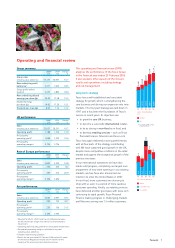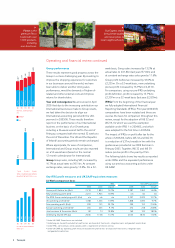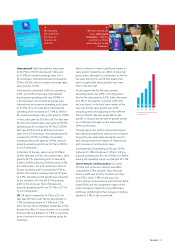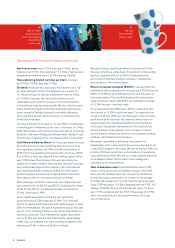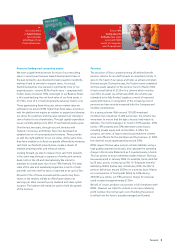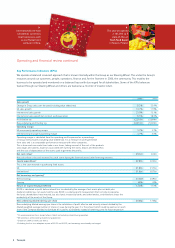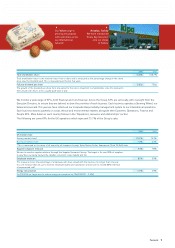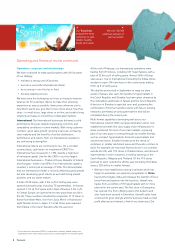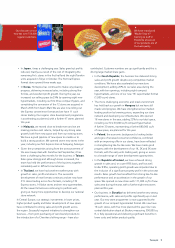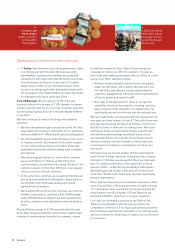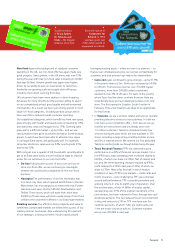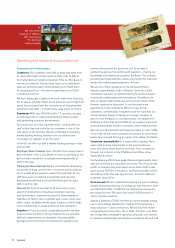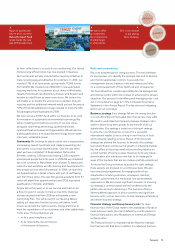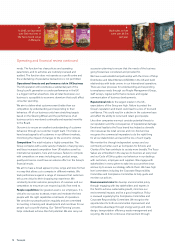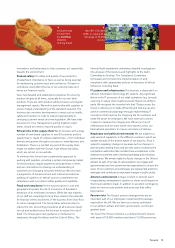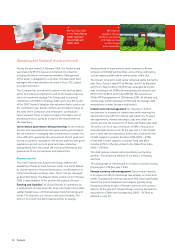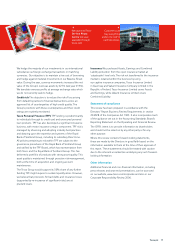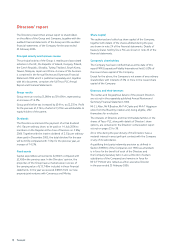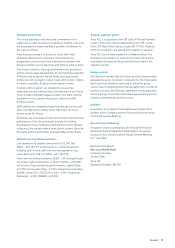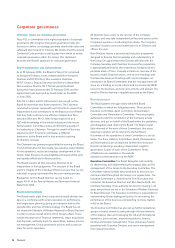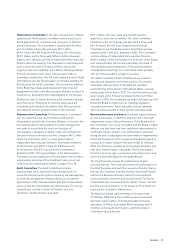Tesco 2006 Annual Report Download - page 13
Download and view the complete annual report
Please find page 13 of the 2006 Tesco annual report below. You can navigate through the pages in the report by either clicking on the pages listed below, or by using the keyword search tool below to find specific information within the annual report.
11Tesco plc
Non-food Against the background of subdued consumer
spending in the UK, our non-food offer has again made very
good progress. Sales growth, in the UK alone, was over 13%
during the year with total non-food sales increasing to £6.8bn
(last year £6.0bn). Volume growth was again even higher,
driven by our ability to pass on lower prices to customers,
funded by our growing scale and supply chain efficiency,
including more direct sourcing from Asia.
UK consumers have been more cautious in their shopping
behaviour for many months but they remain willing to spend
on our competitively priced, good quality and well-presented
merchandise. As a result, we have seen strong growth in most
large non-food categories, including product groups which
have seen flat or reduced overall consumer spending.
Our established categories, which benefit less from new space,
grew strongly, with health and beauty sales increasing by 10%
and stationery, news and magazines by 17%. Clothing sales
grew well in a difficult market – up by 16% – and we saw
strong market share gains by volume and value. Some product
groups, to which we have been able to allocate more space
in our larger Extra stores, did particularly well. For example,
consumer electronics sales were up 34%, sports goods 31%
and books 52%.
With only just over aquarter of UK households currently able to
get to an Extra store easily, we are looking at ways to improve
access for our customers to our non-food offer:
•On-line Following the success of tesco.com and our in-
storenon-food offer, we are continuing to investigate
whether we could build a substantial on-line non-food
business.
•Homeplus The performanceof our firstHomeplus trial
non-food only store, which opened last October in Denton,
Manchester, has encouraged us to extend the trial. Further
trial stores will open shortly in Bristol, Southampton and
Telford. These stores, which will trade from more than
30,000 sqft sales area, will stock a wide range of non-food,
similar tothe assortment offered in our Extra hypermarkets.
Retailing services Our efforts to bring simplicity and value to
sometimes complicated markets are behind the success of our
retailing services businesses. Also underpinning this element
of our strategy is a strong economic model, based around
leveraging existing assets – either our own or a partner’s – so
that we can simultaneously price our services competitively for
customers and also achieve high returns for shareholders.
•tesco.com sales continued to grow strongly – up by 31.9%
in the year to almost £1bn. Profit also increased by 54.9%
to £56.2m. The business now has over 750,000 regular
customers, more than 200,000 orders a week and
represents over 3% of UK sales. For parts of the country
where Tesco has few stores or where those we have are
exceptionally busy, we have developed a tesco.com-only
store. The first opened in Croydon, South London in
February. Only a few locations are likely to be appropriate
for this format.
• In Telecoms,we are a product retailer and also an operator
providing telecoms services to our customers. In both we
now have a very competitive offer – from pay-as-you-go
mobiles to home phones and we already serve over
1.5 million customers. Telecoms introduced many new
services during the year, which are now available in 350
stores, including a range of pay-monthly mobiles on-line
and Tesco internet phone. We opened our first dedicated
Telecoms centre(inside our Slough Extra) during the year.
•Tesco Personal Finance (TPF) has delivered a good
performancein a difficult financial services market. On a
pre-IFRS basis, total operating profit increased slightly to
£205m, of which our shareis £103m. Net of interest and
tax, and the other reporting changes required by IFRSs,
profit reduced to £139m (last year £142m) of which our
shareis £70m. After a flat first half, in which market
conditions in two of TPF’s core markets – credit cards and
motor insurance – were challenging, TPF saw a stronger
second half performance. TPF is providing excellent and
growing returns in only its eighth year of operation. Over
the last two years, a total of £86m of surplus capital,
representing over 37% of the original investment in the
joint venture, has been returned to Tesco through two cash
dividend payments. This has reduced Tesco’s net investment
in the joint venture to £141m. TPF now have over 5m
customer accounts, of which 1.8m are credit cards and
1.4m are motor insurance policies. Customer numbers
areup over 200,000 on last year.
4
Since the launch of
Computers for
Schools in 1992
we have given over
£100 million worth of
equipment to schools.
3
30,000 members
of Tesco Sports
for Schools and
Clubs –the biggest
initiative of its kind.


